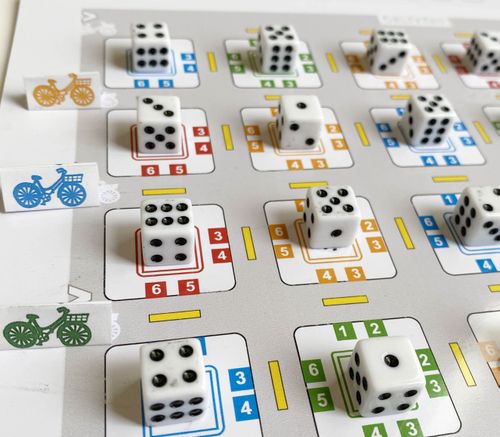Description
BIKE DELIVERY:
A game of dice collecting and strategy
SET UP
Dice must be placed one by one on the 12 available squares of the first half of the board (the first 3 columns).
Then the players dispute the die who starts the game. Whoever is first has the right to choose the exit point before others, but whoever makes the first move is the player who came in second and so on.
HOW TO PLAY
On their turn, each player may move along the paths in 2 different ways:
1) Along the asphalt streets (gray): they may move 1 square at a time, ahead or to the sides.
2) Along the fast bike lanes (brown): 2 squares at a time, ahead or to the sides.
Each player may make their move and collect the die at the door with a number equal to the die in the center.
In this case, the Player has reached door #3 of the green house and may collect the die with number 3.
CHOOSING THE DICE
You must choose and collect dice, trying to pick up those which will provide the best total, and find the best trajectory to take them to their destination.
Choices must take into consideration the number and color of the dice, which grants special features to each of their number:
- Blue - Increase the number on the die by 1 (+1);
- Red - Reduce the number on the die by 1 (-1);
- Green - Allows an extra move (>1);
- Orange - Double the number of the next die to be picked up (x 2).
Dice that are collected go to each player's marker on the TALLY CHART.
END OF THE FIRST STAGE
When a player reaches any position of the 4th column - where there is a traffic light in the middle of the game board - the first stage of the game ends.
All the dice to the left of that column are removed and rolled again, completing the 12 squares of the second stage, from the 5th to the 8th column.
Players keep their current position and game resumes with the next player after the one who first reached the middle of the game.
IMPORTANT DETAILS
Picking up 2 dice
In some cases, a player's movement will allow them to pick up 2 dice (or more):
- When they pick up a green die and make an extra move, they may pick up a second die;
- If they reach a square in which both door numbers allow them to pick up both dice;
- On the fast lane, if they move 2 squares and pass by doors with the same numbers of the dice, they may pick up both.
Extra movement
Picking up 2 green dice only allows for 1 extra move. On the fast lane, picking up a green die also provides an extra move (i.e., a third move).
Changing direction
If a player wants to change direction during the game, they may spend one action/movement to make that inversion.
Doubled dice
The player who picked up an orange die will pick that one with its normal value and double the next die - even if that just happens on the next round. The die with doubled value will go to the gray area of dice tally.
Blocking
A player may not occupy the same square as another player. To move, they must go in a different direction. A player may also choose not to move.
Movement from the brown lane to the gray lane
When leaving the brown lane to the gray lane, a player doesn't lose the second movement. It may be performed in the gray area. To have a second movement in the brown area, the first movement must be in that lane as well.
ENDING THE GAME
To end a game, each player must have picked up at least 1 die of each color.
When a player reaches one of the arrival points, the game ends, and the other players may still play their last turn.
Besides the scoring from the dice, some Bonuses* may also be acquired by players:
- First in Stage 1 (+2 points);
- First in the Final Stage (+2 points);
- Player with the most dice (+3 points).
The total sum of dice and bonuses determines the winner. If they are tied, the winner is the player who collected the most dice.


Comments (0)